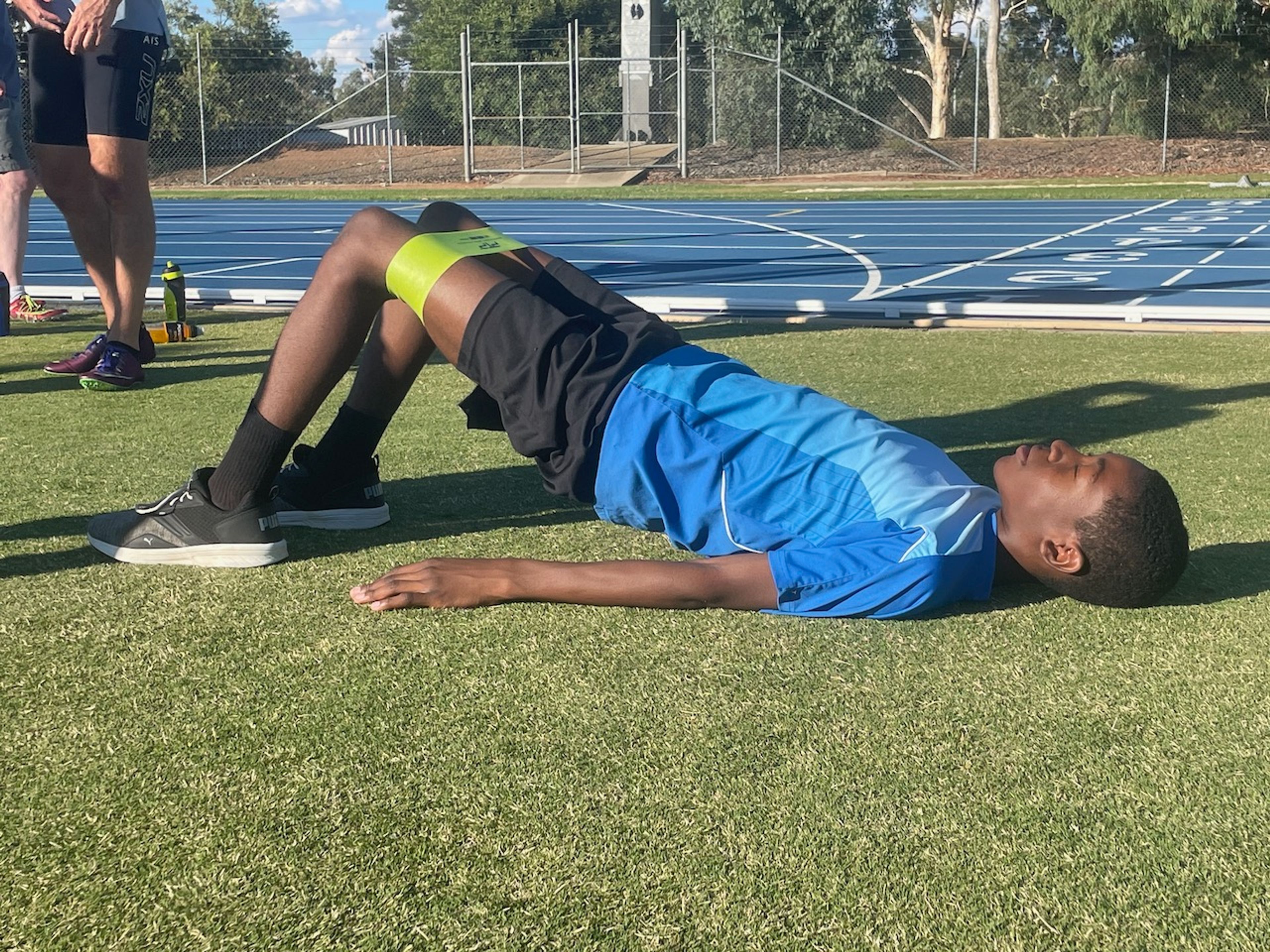11 Effective Resistance Band Workouts to Strengthen Your Legs
Unlock leg strength with 11 resistance band workouts. From squats to plyometrics, perfect for athletes and fitness enthusiasts on the go.
When you’re an athlete, you know the importance of being prepared. Whether it’s game day or just a training session, you’ve probably got your backpack packed with the essentials. Adding a couple of resistance bands to that kit can be a game-changer. Why? They’re light, affordable, and versatile—and they’re one of the most powerful, often-overlooked tools for strengthening your legs. You don’t need a pricey setup; just two or three $10 bands from any athletic store are all it takes to start unlocking some serious gains.
Incorporate resistance band workouts into your fitness routine by blending them into various parts of your workout, such as warm-ups and main sessions.
Resistance bands can do it all, from stretching and warming up to a full-body workout. But today, we’re diving into leg training specifically. These exercises are perfect to tackle after a track workout, bounding drills, or some hurdle mobility. With just a few minutes, you can fire up every muscle in your lower body, adding strength and stability where you need it most.
Ready to feel the burn? Let’s get started! Here’s a resistance band workout designed to make your legs stronger, faster, and more powerful—perfect for any athlete on the go.
11 Effective Resistance Band Workouts to Strengthen Your Legs
Strengthen your legs with these targeted resistance band exercises like resistance band squats. Start with Banded Squats and Lunges to engage your quads, glutes, and hamstrings, followed by Glute and Hip Exercises like glute bridges, clamshells, and side-lying leg lifts to activate key muscle groups. Resistance band leg workouts are highly effective for targeting various lower body muscles, providing constant tension and enhancing glute activation. Leg Lifts and Extensions add focus on quads and hips, while Single-Leg Squats and Lunges challenge balance and build unilateral strength. Add Banded Plyometric Exercises like jump squats to boost explosive power, and finish with Lateral Band Walks and Monster Walks to strengthen lateral stability in the hips and knees.
Benefits of Using Resistance Bands for Leg Strengthening
Resistance bands are one of the most effective yet simple tools for leg strengthening. Here’s why they’re worth including in your routine:
Improved Strength and Flexibility: Bands provide opposing force, requiring your muscles to work harder with each rep. This leads to improved muscle tone, flexibility, and mobility. It's important to keep the upper body still while performing various lower body movements to ensure effectiveness and prevent injury.
Low-Impact for Joint Health: The elastic resistance is gentle on joints, making bands ideal for those with joint issues or those looking to reduce injury risk.
Portable and Lightweight: Easily fit them into your backpack or gym bag, and they’re perfect for home, gym, or travel workouts.
Versatile for Muscle Activation and Burnout: Resistance bands are perfect for “waking up” muscles before a workout or exhausting specific muscle fibers afterward for maximum gains.
Engage Key Lower Body Muscles: They’re excellent for targeting the glutes, hamstrings, quadriceps, and inner thigh muscles (adductors), offering a complete lower body workout. Remember to return to the starting position during exercises to maintain stability and effectiveness in targeting specific muscle groups.
Choosing the Right Resistance Band for Your Workouts
Picking the right band is essential to ensure you’re training effectively and safely:
Weight Range: Bands come in various resistance levels, from extra light to ultraheavy. Start with a level that lets you complete 12-15 reps with good form.
Progressive Resistance: If you find yourself easily surpassing 15 reps, it’s time to move up to a heavier band.
Type of Exercises: Consider the exercises you plan to do and the level of resistance needed for each. Squats may require more resistance, while leg lifts might need lighter tension.
Material and Durability: Look for high-quality materials that withstand regular use to avoid snapping or stretching out.
Preparing for Resistance Band Exercises
Getting started with resistance bands doesn’t require much, but proper preparation is key:
Warm-Up: Begin with light cardio and dynamic stretching to prep your muscles.
Read the Instructions: Familiarize yourself with each exercise and proper form to avoid strain or injury.
Start Light: Gradually increase resistance as you build strength, allowing your body to adapt.
Check Your Form: Use a mirror to ensure correct posture, alignment, and technique. Proper form ensures you’re hitting the target muscles effectively. Keep the band taut during exercises like the diagonal band walk to effectively target the hip and glute muscles.
Essential Resistance Band Exercises for Legs
These are the core moves to kickstart your banded leg training. They cover all major muscle groups in the lower body. The left foot plays a crucial role in various resistance band exercises, enhancing movement, balance, and targeted engagement of the glute and thigh muscles.
Exercises like clamshells and fire hydrants focus on strengthening the glute muscles and require raising the left knee, emphasizing proper form and controlled movements to avoid shifting the hips.
During lateral band walks, the positioning of the right foot is essential for effective engagement of the targeted muscle groups, such as the glutes and thighs.
1. Banded Squats and Lunges
Squats and lunges with resistance bands, such as resistance band squats, add intensity to your movements, challenging your quads, glutes, and hamstrings.
Squats: Stand with feet hip-width apart, holding the resistance band securely. Lower into a squat, keeping knees bent and back straight. Push through your heels to rise.
Reps: 12-15 reps.
Lunges: Step out with one foot and keep the other behind. The band adds tension as you lunge forward.
Reps: Alternate legs, completing 12-15 reps per side.
2. Glute and Hip Exercises
To activate glutes and hips, place the band around your thighs and use moves like glute bridges, clamshells, and side-lying leg lifts.
Glute Bridge: Lie on your back with knees bent, feet flat, and band around thighs. Lift hips towards the ceiling, squeezing glutes.
Reps: 12-15 reps.
Clamshells: Lie on your side, bend knees at 45 degrees, and lift your top knee while keeping your feet together. Focus on raising your left knee without shifting your hips.
Reps: 15 reps per side.
3. Leg Lifts and Extensions
Leg lifts and extensions are excellent for targeting your quads and hips.
Side Leg Lifts: Place the band around your ankles and lift one leg out to the side, keeping it straight. Make sure to lift your left leg out to the side, maintaining balance and muscle engagement.
Reps: 12-15 reps per side.
Leg Extensions and Curls: These moves with a band around your ankles target your quadriceps and hamstrings. Stand upright and extend or curl one leg against band resistance.
Reps: 12-15 reps per side.
Advanced Resistance Band Leg Workouts
For a challenging workout, try these advanced moves that combine strength with balance and power. Resistance band leg workouts are particularly effective for targeting various lower body muscles, such as the glutes, hamstrings, and quadriceps.
4. Single-Leg Squats and Lunges
Single-leg movements challenge your balance and help build unilateral leg strength.
Single-Leg Squats: Stand with one foot forward and one back, bending the front knee while keeping the back leg off the ground. Focus on engaging your left leg to maintain balance and muscle engagement.
Reps: 8-10 reps per leg.
Lunges with Band Resistance: Add a heavier band to increase tension and make lunges even more challenging.
5. Banded Plyometric Exercises
Plyometric exercises, like banded jump squats and box jumps, add explosive power to your workout, working fast-twitch muscle fibers.
Jump Squats: Stand on the band, holding each end, and jump up, keeping tension throughout.
Reps: 3 sets of 10 reps.
6. Lateral Band Walks and Monster Walks
Lateral and monster walks target glutes and hips, stabilizing your knees and building lateral strength.
Lateral Band Walks: Place the band just above your knees and step side-to-side, ensuring your right foot leads the movement to effectively engage the glutes and thighs.
Reps: 15 steps each side.
Monster Walks: A wider stance variation that works inner thighs, glutes, and outer hips.
Reps: 15 steps forward and back.
Creating a Well-Rounded Workout Routine with Resistance Bands
To get the best results from your resistance band workouts, plan to include them in your routine 2-3 times a week. Start with lighter resistance and increase the tension as you progress. Mixing up exercises helps target different muscle groups and avoids plateaus. Incorporate resistance band workouts into your fitness routine by blending them into various parts of the workout, such as warm-ups and main sessions, emphasizing their ease of use and accessibility for all fitness levels.
Cardio and Stretching: Don’t forget to include cardio and flexibility work in your routine to maintain well-rounded fitness.
Muscle Recovery: Take time to warm up and cool down properly, as resistance bands can fatigue muscles, especially when performing high-rep sets.
Tips for Getting the Most Out of Your Resistance Band Workouts
To maximize your results and ensure you’re training safely:
Start Slow: Gradually increase resistance and intensity to build endurance without risking injury.
Prioritize Form: Good form ensures each exercise targets the intended muscle group effectively.
Use Variety: Incorporate different moves and resistance levels to keep workouts fresh and prevent overuse.
Warm Up and Cool Down: Properly warming up and cooling down with light cardio and stretches improves performance and recovery.
Resistance bands bring an incredible amount of versatility and challenge to your leg workouts. They’re ideal for athletes who want to build strength and explosiveness without relying on heavy weights. When performing exercises like the diagonal band walk, make sure to keep the band taut around your ankles to effectively target the hip and glute muscles. Incorporate these moves into your routine, and you’ll feel the results as your legs become stronger, more stable, and more powerful. Grab a few bands, find your favorite exercises, and get ready to unleash the full potential of resistance training!
Common Mistakes to Avoid
When incorporating resistance band workouts into your routine, it’s essential to avoid common mistakes that can lead to injury or ineffective results. Here are some mistakes to watch out for:
Insufficient Warm-Up: Before starting a resistance band workout, make sure to warm up your muscles with 5-10 minutes of light cardio and dynamic stretching. This will help prevent muscle strains and improve flexibility.
Poor Form: Maintain proper form and technique when performing resistance band exercises. Avoid arching your back, bending your knees excessively, or using momentum to lift the weight. Proper form ensures you’re targeting the intended muscles effectively.
Inconsistent Tension: Ensure the resistance band is taut throughout the exercise, but not too tight. Adjust the band’s length or resistance level as needed to maintain a consistent challenge. This helps in maximizing the effectiveness of each movement.
Overreliance on Momentum: Avoid using momentum to lift the weight or complete the exercise. Instead, focus on slow, controlled movements that engage your muscles. This ensures that you’re working the muscles properly and reducing the risk of injury.
Ignoring Proper Breathing: Breathe naturally and avoid holding your breath during exercises. Exhale during the most challenging part of the movement and inhale during the easier part. Proper breathing supports muscle function and endurance.
Not Adjusting the Band: Failure to adjust the resistance band to accommodate different exercises or muscle groups can lead to ineffective workouts or injury. Make sure to modify the band’s position and tension according to the exercise.
Not Incorporating Variety: Vary your resistance band exercises to target different muscle groups and prevent plateaus. Incorporate exercises that work multiple planes of motion, such as side-to-side, rotational, forward, and backward movements. This keeps your workouts dynamic and comprehensive.
Not Listening to Your Body: If you experience pain or discomfort during a resistance band exercise, stop immediately and modify the exercise or rest. Listening to your body helps prevent injuries and ensures a safe workout.
By avoiding these common mistakes, you can ensure a safe and effective resistance band workout that targets your lower body and helps you achieve your fitness goals.
Conclusion
Resistance bands are a versatile and effective tool for strengthening your lower body. With their space-saving design and budget-friendly price, they’re an excellent addition to any home gym or strength training routine. By incorporating resistance band exercises into your workout routine, you can target different parts of your legs, improve overall development, and prevent injuries.
Remember to focus on proper form and technique, adjust the resistance band as needed, and incorporate variety in your workouts. Avoid common mistakes, such as insufficient warm-ups, poor form, and overreliance on momentum.
With consistent practice and patience, you can achieve stronger, more toned legs using resistance bands. Whether you’re a beginner or an experienced athlete, resistance bands offer a convenient and effective way to step up your leg workouts at home.









